Domestic hybrid of cucumbers "Garland", which will delight you with a rich harvest
Garland is a popular and early hybrid of cucumbers that is grown in greenhouses and even on a balcony or loggia. These vegetables contain only 15 kcal per 100 g, which makes this a dietary product. All about the features of cultivation of a hybrid, its advantages and characteristics - below.
The content of the article
Description of the hybrid
Garland refers to early maturing hybrids... Plants are self-pollinated, which makes it easier to grow cucumbers in greenhouse conditions. The culture is characterized by powerful growth and bouquet-setting of ovaries. The hybrid does not require special care and gives a high yield.
Important! Do not confuse Garland with a hybrid Siberian Garland. Although the names are similar, the plants themselves differ in characteristics.
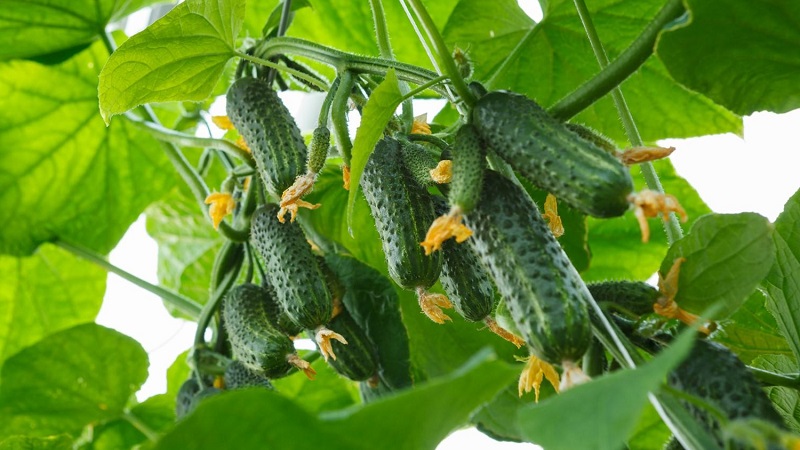
Distinctive features
Cucumber The garland has a female flowering type... The culture has a strong immunity to the characteristic diseases of cucumbers. When growing greenery in warm regions, the crop is harvested until the end of September.
Reference. The garland is a hybrid, not a variety, so seeds from their own harvest are not harvested for further crops. Such grains have an underdeveloped structure.
Composition of properties, benefits, calorie content
Nutritional value per 100 g of product is:
- proteins - 0.9 g;
- fats - 0.1 g;
- carbohydrates - 2.7 g;
- fiber - 0.7 g
Also these vegetables contain a small amount of vitamins C, PP, E and group B. Cucumbers consist of 90-95% structured water, they perfectly quench thirst and remove toxic substances from the body.
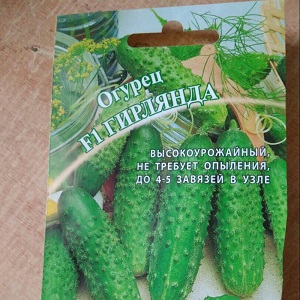 The fruit contains natural organic acid. This connection performs a number of useful functions:
The fruit contains natural organic acid. This connection performs a number of useful functions:
- dissolves sand and kidney stones;
- washes away free radicals;
- removes cholesterol plaques from blood vessels;
- removes salts from joints;
- improves blood counts.
This healthy vegetable can be used on fasting days in large quantities, excess weight will not be gained.
Read also:
Specifications
Fruits ripen in 40-50 days after emergence. During the period of active fruiting, up to 35 vegetables are harvested at a time from one bush.
Cucumber shape is cylindrical, color is dark green... The length of the fruits is 12-14 cm, the diameter is 3-3.5 cm. The weight of one vegetable reaches 130 g. On the fruits there are large pimples with white pubescence. Leaves are medium in size, heart-shaped, with jagged edges.
These cucumbers have a pleasant taste and aroma... Vegetables are versatile in use. Summer salads and winter preservation are made from them.
In the central and northern regions the garland is grown indoors. From 1 sq. m vegetable growers collect 14-16 kg of cucumbers.
How to grow cucumbers yourself
The timing of planting seeds depends on the method of growing cucumbers... Direct sowing of seeds into the ground is carried out in late May – early June, if the ground has warmed up to + 15 ° С. Grains are planted for seedlings in the last decade of April.
Interesting!The record cucumber was grown by a British gardener named Alfo Cobb. The length of the fetus was 91.7 cm.
The hybrid is recommended for growing in greenhouses... Also, the Garland is successfully cultivated on balconies and loggias.
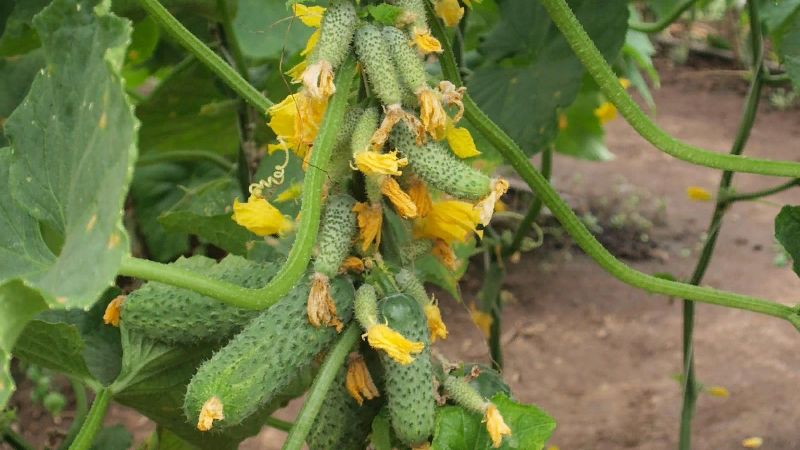
Direct planting of seeds in the ground
With the seedless method, the seeds are planted immediately to a permanent place of growth. The main advantage of this method is that you do not have to spend time and effort growing seedlings. But there is a risk that not all seeds will sprout. In this regard, the seedless method is inferior to the seedling method, where the seedlings have already grown and take root in the ground without problems. Also, cucumbers will begin to bear fruit later than when planting seedlings.
On the quality of the crop influences the place for growing cucumbers... Seeds are sown in non-acidic loamy or sandy loam soil. Crop rotation plays an important role. Good precursors for cucumbers:
- beans;
- beans;
- garlic;
- onion;
- peas;
- cabbage;
- corn;
- potatoes;
- tomato.
Cucumbers not re-grown in the same place or after melons... Before sowing, the soil in the greenhouse is properly prepared. The soil is dug up and organic fertilizers are applied to it. For this, rotted manure is used at the rate of 20 liters per 1 sq. m plot. The holes are dug at a distance of 30 cm from each other. 70 cm are left between the rows.Seeds are deepened into the soil by 2-4 cm.
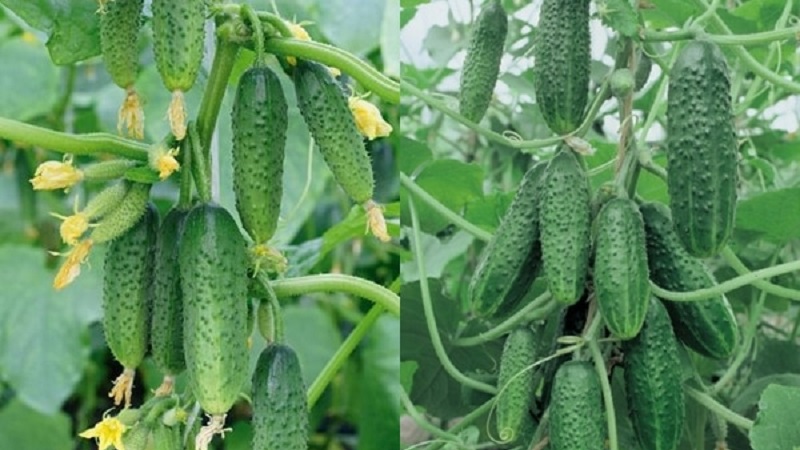
Growing seedlings
For hybrid Garland the seedling method of growing is more suitablethan reckless. The relative disadvantage of the method is laboriousness and time consumption.
The best seedling container is peat tablets... The finished disinfected soil stimulates the development of seedlings. The tablets are placed in a container and filled with water. When they have absorbed the water (after 15 minutes), the seeds are planted.
The seeds are deepened into tablets by 1-2 cm, the latter are placed in a common box, which is covered with polyethylene or transparent glass and placed in a dark place. The substrate is periodically moistened with a spray bottle.
When the seedlings germinate, the shelter is removed. Seedlings are transplanted to a permanent place in late spring or early summer. The planting scheme is the same as in the non-seedling method: 30 cm is left between the plants, and 70 cm between the rows.
Growing and care
Cucumber is a moisture-loving plant. Special it is important to provide the culture with moisture in hot weather... At the first stages of development, when the plants have not yet formed a powerful root system, cucumbers are watered at least 2 times a week, while consuming 4-5 liters of water per 1 sq. m. During flowering and fruit setting, the amount of water is increased to 10-12 liters.
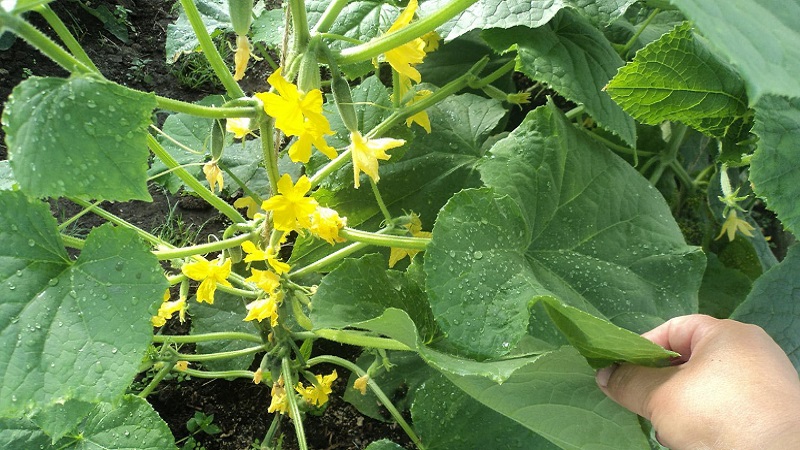
With a lack of water for irrigation, soil mulching is carried out... This will significantly reduce the evaporation of moisture from the soil. The garden bed is mulched with a layer of 7 cm. To do this, use compost, peat, manure, needles or straw. Waterlogging of the culture is not allowed - this will lead to the development of infectious diseases.
The soil around the bushes is loosened and at the same time gets rid of weedswhich takes nutrients and moisture from plants. The event is carried out 12-24 hours after watering the cucumbers.
The frequency of loosening depends on the type of soil... When growing cucumbers on light sandy soil, loosening is dispensed with. If the earth contains clay, then this procedure is carried out regularly. This will provide oxygen access to the root system, which will positively affect the yield of cucumbers.
For the entire growing season, cucumbers are fertilized up to 6 times... For this, mineral and organic dressings are used. The first feeding of plants is carried out at the beginning of flowering, the subsequent ones - every three weeks.
Fertilization methods:
- ash infusion (200 g per bucket of water);
- solution of urea, potassium sulfate and superphosphate (1 tbsp. l. per 10 liters of water);
- infusion of chicken manure or mullein (in a ratio of 1:15).
At the initial stage, they make nitrogen fertilizers... Subsequently, the concentration of potassium and phosphorus is increased. Many gardeners alternate between organic and mineral fertilizing. Fertilizers are applied at the root on moistened soil. In cool weather, the plants are not fed, since the culture poorly assimilates nutrients.
The garland is grown vertically... To do this, the bushes are tied to a regular mesh or trellis.This makes it easier to care for plants, and the culture receives more sunlight.
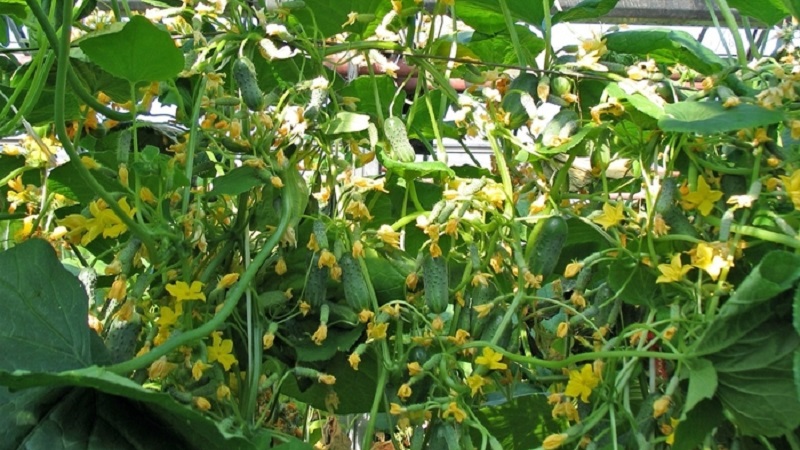
Features of cultivation and possible difficulties
Agrotechnics of growing cucumbers Garland is practically no different from caring for other cucumber crops.
Did you know? In some cities, monuments to cucumbers were erected (Lukhovtsy, Nizhyn). And on July 27, vegetable growers celebrate International Cucumber Day.
Diseases and pests characteristic of cucumbers
Since the cucumber Garland is a hybrid, the culture is little exposed to diseases, but a certain risk always remains... In such cases, the plants are treated with special preparations. In order not to harm the cucumbers, the funds are used strictly according to the instructions on the package.
Most common diseases of cucumbers:
- Powdery mildew... The disease manifests itself as white spots on the foliage, which later spread to the entire plant. At the same time, the leaves begin to dry out, and fruiting stops. The damaged parts are cut off, and the bush itself is treated with fungicidal preparations, such as "Ridomil Gold" or "Previkur". If the disease has spread to the entire plant, it is removed.
- Cladosporium... Brown sores appear on bushes and fruits. To combat the disease, watering is stopped for 5 days and the culture is treated with Fundazol (10 g per bucket of water). The infected areas are cut off.
- White rot... It is a viscous white consistency, due to which fruits and bushes begin to rot. Plants are treated by removing the affected parts and processing with a special solution (10 g of copper sulfate, urea and zinc sulfate per 2 liters of water).
- Downy mildew... The foliage is covered with small yellow spots and begins to dry. In the future, the disease spreads to the entire bush. Moistening and fertilization are stopped for 3-4 days and the culture is treated with "Polycarbacin" (10 g of the product per 5 liters of water).
On a note. The disease is fought at the first stages of its development, otherwise the plants will die, and diseases will spread to neighboring crops.
In the process of growing pests often attack cucumbers... This mainly occurs during the fruiting period.
 Most common pests:
Most common pests:
- Aphid... Tiny green insects that eat foliage, causing green matter to wither. These bugs multiply quickly. Spraying the plants with an ash solution helps from the pest (200 g of wood ash and 100 g of soap are stirred in 10 liters of water).
- Whitefly... Small white midges that suck sap from plants and leave behind a sooty fungus and wilted leaves. Moshkara is destroyed using garlic infusion (200 g of grated garlic or onion is stirred in 10 liters of water and allowed to brew for a day). The whole plant is treated with the prepared agent.
- Spider mite... The pest is located on the back of the leaves, where it leaves behind a cobweb. Small spiders bring various infections and eat foliage. The mite is destroyed by spraying the back of the leaves with soapy water (200 g of grated laundry soap in a bucket of water).
When pests are identified on plants, they are immediately destroyed., since insects multiply quickly and move to neighboring bushes.
Harvesting and application of the crop
For high and long-lasting yields, cucumbers are harvested on time. Timely collection of vegetables stimulates the setting of new fruits. The first zelents are removed approximately 40 days after germination.
Cucumbers mostly used for making summer salads, but their scope is wide. Small greens are perfect for pickling or winter storage.
Important! At temperatures below 0 ° C, cucumbers become soft and spoil quickly. In the refrigerator, the fruits are stored away from the freezer.
Advantages and disadvantages
Advantages of Cucumber Garland:
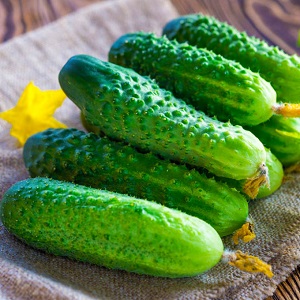 high productivity;
high productivity;- self-pollination of plants;
- quick return of the crop;
- prolonged fruiting;
- the culture has a strong immunity to disease;
- cucumbers are good for the body;
- excellent taste;
- transportability of vegetables;
- attractive presentation of cucumbers;
- culture doesn't need much attention.
Disadvantages of a hybrid:
- high cost of seed;
- the inability to collect seeds from their own harvest for further crops.
Reviews
Summer residents who have already grown the Garland speak about the hybrid mainly from the positive side. The culture has gained enduring popularity for its long list of virtues.
 Anastasia, Moscow region: “I have been growing the garland for 3 years in a row and only through seedlings. Seed germination is high, many ovaries are formed. The cucumbers have excellent taste, the skin is hard and crispy.
Anastasia, Moscow region: “I have been growing the garland for 3 years in a row and only through seedlings. Seed germination is high, many ovaries are formed. The cucumbers have excellent taste, the skin is hard and crispy.
Zelentsy grow beautiful, as in the photo of the package with seeds. I use this cucumber for winter preparations, it looks very appetizing in a jar ".
Svetlana, Shakhty: “Recently my husband and I bought a summer cottage. I have never grown cucumbers before. A neighbor advised me to plant Garland.
I cultivated the hybrid in seedlings. She devoted a little time to the plants, watered and weeded the soil as needed. Several times she fed the culture with a mullein. Harvested a lot, did not even know what to do. Delicious vegetables were eaten fresh and used for preservation. My family liked the cucumbers Garland. I will continue to grow ".
Conclusion
Hybrid Garland has strong immunity to diseases and shows high yields regardless of the method of cultivation. The plant is self-pollinated, bears fruit for a long time and grows even on windowsills or loggias. The garland does not require careful maintenance, so even an inexperienced vegetable grower can handle the cultivation of these cucumbers.
You will learn more information about the Garland hybrid from the video below: